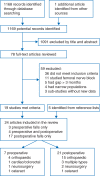Review of perioperative falls
- PMID: 27956670
- PMCID: PMC5155561
- DOI: 10.1093/bja/aew377
Review of perioperative falls
Abstract
Falls are a known public health problem, and there is increasing recognition of the importance of perioperative falls for risk prediction and quality assessment. Our objective was to review existing literature regarding the occurrence, injuries, and risk factors of preoperative and postoperative falls. A systematized search of PubMed entries between 1947 and November 2015 produced 24 articles that met inclusion criteria. Most studied orthopaedic surgery patients older than 65 yr. Four were rated 'good' quality. Interrater reliability for the quality assessment was moderate (κ = 0.77). In the 3-12 months before surgery, the proportion of preoperative patients who fell ranged from 24 to 48%. Injuries were common (70%). The rate of postoperative falls ranged from 0.8 to 16.3 per 1000 person-days, with a gradual decline in the months after surgery. Injuries from postoperative falls occurred in 10-70% of fallers, and 5-20% experienced a severe injury. Risk factors were not well studied. Prospective studies reported a higher percentage of falls and fall-related injuries than retrospective studies, suggesting that there may be underdetection of falls and injuries with retrospective studies. Perioperative falls were more common than falls reported in the general community, even up to 12 months after surgery. Surgery-related falls may therefore occur beyond the hospitalization period. Future studies should use a prospective design, validated definitions, and broader populations to study perioperative falls. In particular, investigations of risk factors and follow-up after hospitalization are needed.
Registry number: PROSPERO registration number CRD42015029971.
Keywords: accidental falls; postoperative period; preoperative period.
© The Author 2016. Published by Oxford University Press on behalf of the British Journal of Anaesthesia. All rights reserved. For Permissions, please email: journals.permissions@oup.com.
Similar articles
-
Preoperative Falls Predict Postoperative Falls, Functional Decline, and Surgical Complications.EBioMedicine. 2016 Oct;12:302-308. doi: 10.1016/j.ebiom.2016.08.039. Epub 2016 Aug 26. EBioMedicine. 2016. PMID: 27599969 Free PMC article.
-
Characteristics of hospital inpatient falls across clinical departments.Gerontology. 2008;54(6):342-8. doi: 10.1159/000129954. Epub 2008 May 6. Gerontology. 2008. PMID: 18460867
-
Characteristics and circumstances of falls in a hospital setting: a prospective analysis.J Gen Intern Med. 2004 Jul;19(7):732-9. doi: 10.1111/j.1525-1497.2004.30387.x. J Gen Intern Med. 2004. PMID: 15209586 Free PMC article.
-
Preoperative Falls and Their Association with Functional Dependence and Quality of Life.Anesthesiology. 2016 Aug;125(2):322-32. doi: 10.1097/ALN.0000000000001167. Anesthesiology. 2016. PMID: 27362869 Free PMC article.
-
[Risk factors for falls in hospitalized adult patients: an integrative review].Rev Esc Enferm USP. 2014 Jun;48(3):540-54. doi: 10.1590/s0080-623420140000300021. Rev Esc Enferm USP. 2014. PMID: 25076284 Review. Portuguese.
Cited by
-
Association of a Perioperative Multicomponent Fall Prevention Intervention With Falls and Quality of Life After Elective Inpatient Surgical Procedures.JAMA Netw Open. 2022 Mar 1;5(3):e221938. doi: 10.1001/jamanetworkopen.2022.1938. JAMA Netw Open. 2022. PMID: 35275166 Free PMC article. Clinical Trial.
-
Validation of the Saga Fall Injury Risk Model.Int J Med Sci. 2024 May 19;21(8):1378-1384. doi: 10.7150/ijms.92837. eCollection 2024. Int J Med Sci. 2024. PMID: 38903917 Free PMC article.
-
Enhancing patient safety: identifying fall risks during patient transfers in operating rooms.BMC Health Serv Res. 2025 Apr 16;25(1):557. doi: 10.1186/s12913-025-12750-5. BMC Health Serv Res. 2025. PMID: 40241044 Free PMC article.
-
Ability of preoperative falls to predict postsurgical outcomes in non-selected patients undergoing elective surgery at an academic medical centre: protocol for a prospective cohort study.BMJ Open. 2016 Sep 21;6(9):e011570. doi: 10.1136/bmjopen-2016-011570. BMJ Open. 2016. PMID: 27655260 Free PMC article.
-
Patient-reported walking difficulty predicting the post-discharge overall function in patients with lung cancer undergoing minimally invasive surgery.J Cancer Surviv. 2025 Jul 3. doi: 10.1007/s11764-025-01859-5. Online ahead of print. J Cancer Surviv. 2025. PMID: 40608233
References
-
- Lamb SE, Jørstad-Stein EC, Hauer K, Becker C; Prevention of Falls Network Europe Consensus Group. Development of a common outcome data set for fall injury prevention trials: the Prevention of Falls Network Europe consensus. J Am Geriatr Soc 2005; 53: 1618–22 - PubMed
-
- Tinetti ME, Speechley M, Ginter SF. Risk factors for falls among elderly persons living in the community. N Engl J Med 1988; 319: 1701–7 - PubMed
-
- Robertson MC, Gillespie LD. Fall prevention in community-dwelling older adults. JAMA 2013; 309: 1406–7. - PubMed
-
- Oliver D, Daly F, Martin FC, McMurdo ME. Risk factors and risk assessment tools for falls in hospital in-patients: a systematic review. Age Ageing 2004; 33: 122–30 - PubMed
Publication types
MeSH terms
Grants and funding
LinkOut - more resources
Full Text Sources
Other Literature Sources
Medical
Miscellaneous


